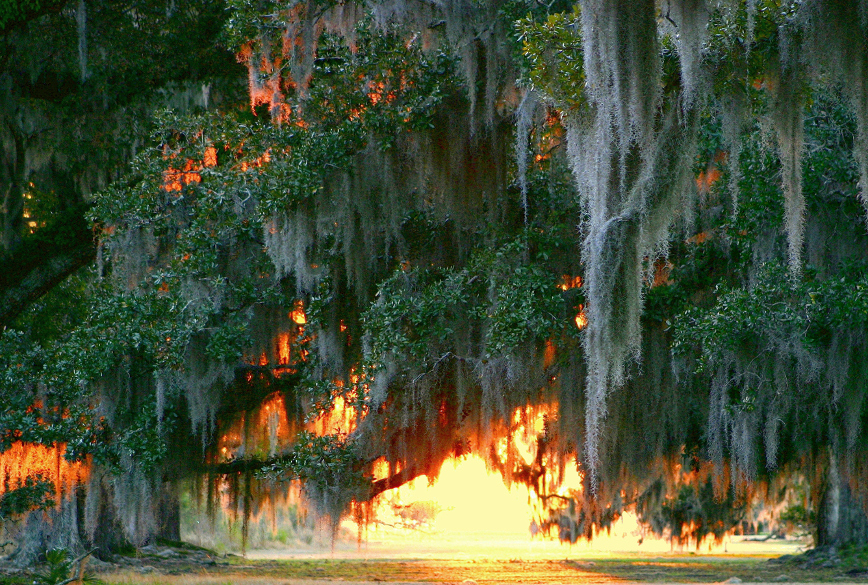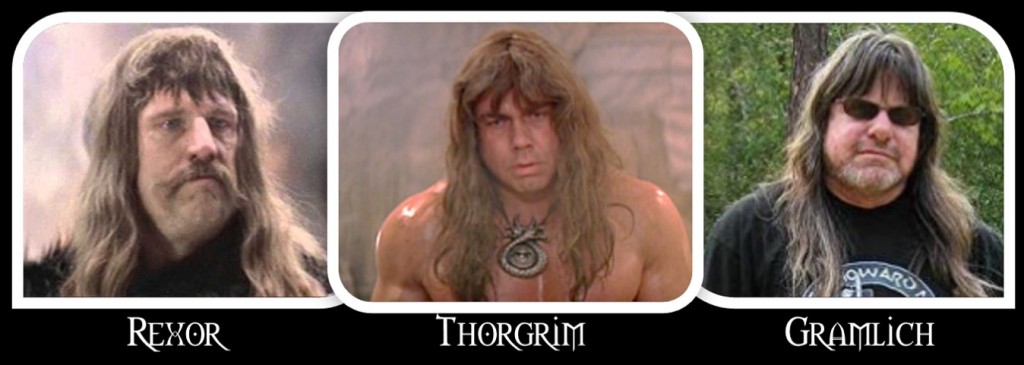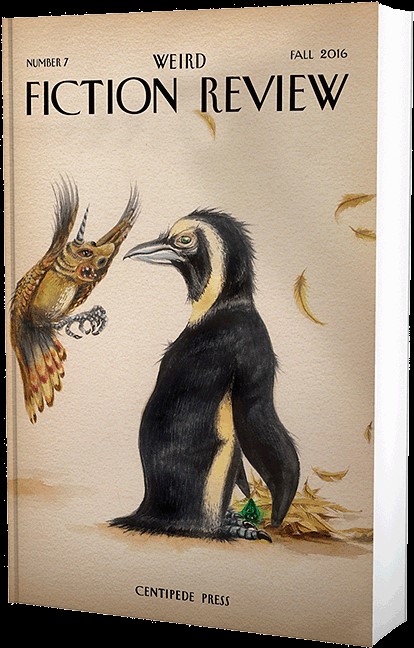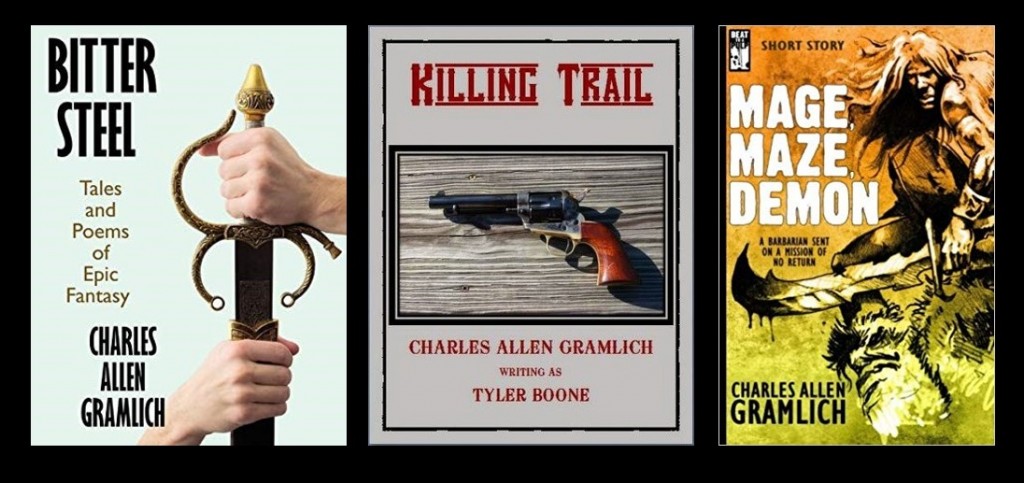The Beautiful and the Repellent: An Interview with Charles A. Gramlich
It is not intuitive to seek beauty in art deemed grotesque, but most authors who produce horror/fantasy actually are usually (a) serious about their craft, and (b) driven by strange muses. Weird fiction masters (Robert E. Howard, Poe, Clark Ashton Smith, H.P. Lovecraft…) held serious beliefs that their “horror” was actually beautiful. This interview series engages contemporary authors & artists on the theme of “Art & Beauty in Weird/Fantasy Fiction.” Previously we cornered weird fantasy authors like John Fultz, Janeen Webb, Aliya Whiteley, Richard Lee Byers, Sebastian Jones, and Darrell Schweitzer.
Charles Gramlich grew up on a farm in Arkansas but moved to the New Orleans area in 1986 to teach psychology at Xavier University. His degree is in Experimental Psychology with a specialization in Physiological Psychology; Charles served as chair of the department several times between 1988 and 2002. He was instrumental in developing the Psychology Pre-medical program for the department. He’s since published eight novels, three nonfiction books, five collections of short stories, and a chapbook of vampire haiku. Charles likes to write in many different genres but all of his fiction work is known for its intense action and strong visuals. Check out his Razored Zen blog and Amazon page.
Previous interviews are revealing: in 2007 Shauna Roberts interviewed Gramlich about his Talera Cycle (also included in Write with Fire) and in 2014 Prashant C. Trikannad’s interview focused on his western Killing Trail. This round we focus on his poetic take on pulp adventure. In addition to publishing many short stories that fit the bill, he published an essay in Weird Fiction Review #7 called “The Beautiful and the Repellent: The Erotic Allure of Death and the Other in the Writers of Weird Tales” (Fall 2016 edition).
In Gramlich’s WF#7 essay he notes how Howard Phillips Lovecraft and Edgar Allen Poe (and many more speculative fiction writers) juxtaposed content that were both repulsive & beautiful. In his words:
Repulsive elements and events are intertwined with the grotesque and beautiful ones — often through the use of poetical prose — thus transmuting the ugly into something that, if not exactly lovely, still compels attention.
He posits two types of repellent beauty in weird fiction (and associated adventure, like Sword & Sorcery/Planet). Here’s a brief overview:
Erotic Allure of Death (EAD) in which sexual taboos and an attraction with death itself is a focus, and…
Erotic Desire for the Other (EDO) which regards “the desire for that which is exotic, which is foreign or alien to one’s own identity and experiences… it disorients readers; it dissociates them from every other sense of order and brings them back to the level of flesh, the messy flesh” – CAG.
Summary quotation: “Many of the most memorable writers in Weird Tales—Lovecraft, Howard, Smith, Dyalhis, Moore — were master at the art of combining attractive and repulsive elements together in the same scene. They blended beauty with horror, turning the deadly and the alien into erotic.” – CAG
SEL: WF#7 issue is sold out via Centipede press, so I’d like to echo some of your perspective here. Can you paraphrase how some of the masters applied EAD and EOD? “Black God’s Kiss” and the use of blood were great examples.
CAG: One thing I’ve noticed about reading such writers as Lovecraft, Robert E. Howard, Clark Ashton Smith, Nictzin Dyalhis, and C. L. Moore is that the emotional power of their prose often comes from interweaving images of beauty with the grotesque. When the grotesque images take the form of death and decay, and yet the protagonist of a story is still attracted to it, I called it EAD (The Erotic Allure of Death). As an example, I mentioned Smith’s “The Seed from the Sepulcher,” where the main character is seduced by a beautiful, parasitic monster that he’s just watched devour his companion. He knows the thing will kill him but cannot fight his attraction to it.
These same writers also often introduced what I call EOD (The Erotic Allure of the Other) into their stories. In Howard’s story, “Worms of the Earth,” Bran Mak Morn must make a bargain with a half-human witch woman of the moors to achieve his revenge on the Romans. The woman is described as both lovely and repellent. Bran is simultaneously disgusted by her and undeniably attracted to her. C. L. Moore did something similar in her story, “Black God’s Kiss,” where Jirel of Joiry comes upon a statue of an abhorrent alien god with its lips pursed for a kiss. Jirel shudders at sight of it, and yet finds herself so drawn to it that she must kiss the awful lips. Neither Bran nor Jirel are expecting or wanting to die, but both find themselves simultaneously attracted and repelled by the inhuman aspects of another being.
Approach Avoidance is a psychology term mentioned in your essay. Can you explain that convey how writers could use such tension for their own character’s dilemmas?
Typically, tension in a story is produced by the protagonist wanting something and the antagonist opposing them. For example, a police officer wants to solve a crime and save a victim from impending death while the antagonist/criminal fights the officer every step of the way. The Approach-Avoidance concept adds a deeper layer to this tension. It puts the protagonist into a position where he, or she, is simultaneously attracted to and repelled by the same goal. For example, imagine that the police officer wants to save a kidnap victim, but, at the same time, knows that saving the victim will destroy the officer’s career because of some secret the victim knows. Now, the protagonist faces two obstacles, an outer and an inner one.
On Writing Poetic Weirdness
You also note that the memorable writers “… expressed it all in poetic prose without becoming either maudlin or prurient.” Writing accessible, poetic fiction is what drew me to you in the first place (see review snippets below). Writing poetically often implies writing abstractly; combined with weird content, this approach risks alienating the reader. Any tips on how to balance poeticism with accessibility?
“Across a snowfield that lies red with dawn, the Orc charge comes. And is met. Axes shriek on shields. Swords work against armor into flesh. The tips of spears are wetted. Gore dapples the snow…” – CAG, Harvest of War
“In the bitter twilight of frost-rimmed peaks, Thal dreamed, the visions crimson with gore. War-horses frothed at their bits, eyes rolling like bloody pearls. Men in bruised armor and torn silks of umber and white hacked each other into ragged scarecrows. Arrows sleeted the sky like sharpened flakes of ice. When it was over the ravens gathered, scarcely moving as Thal rode among them searching. He found [spoiler]’s head on a stake.” -CAG, Bitter Steel,Sword and Sorcery
That question illustrates why this writing thing is still an art rather than a science. You’re absolutely right. Poetic writing can distance the reader from the story, and — I think — is guaranteed to distance some readers from it. Some folks just don’t like language that is highly metaphorical and overtly lyrical. For one thing, it requires more effort to read that kind of writing. And, unless the writer and the reader share certain visual affinities, the images just won’t translate. For example, I recently used the phrase “blackshine” in a poem and several members of my writing group said they just couldn’t picture it. To me, “blackshine” creates a completely concrete visualization. Imagine the shine of black satin under a silvery light. On the plus side, though, if poetic writing does connect to a reader, then the communication between the reader and writer is intensified, and isn’t that what all writers want — to communicate what’s in our heads to someone else?
I think there are some strategies that can help poetic writers communicate better with readers. One thing that you mentioned was “economy.” An economy of words and images is important. Throwing layer after layer of metaphor at the reader will probably lose them all. You select one metaphor, one poetic image, and see it through before adding another. And, whenever possible you temper the metaphorical and abstract qualities of the writing with simple, concrete language.
I like to think the following paragraph from my book Cold in the Light illustrates the process. There’s some metaphorical language (dawn creeping like a fog), and a hint of the mythical (god or demon), but the core of the piece employs simple, everyday terms like death, life, sex, and hunger.
By the time gray dawn came creeping like a fog he had mastered himself. He lived in the place that all warriors sought, where death and life and sex and hunger were one. Where you created your own reality and no one else’s could intrude. Where you became a god, or a demon. And you didn’t care which.
Have you ever employed any EAD or EDO in your own writing?
Absolutely. As I mentioned in the article “The Erotic Allure of Death,” or EAD, is basic to many horror stories, and I’ve written a lot of them. My collection, Midnight in Rosary, is mostly about vampires, and vampires are the most popular manifestation of EAD in our culture. There are very few vampire tales that don’t combine the monstrous lethality of the creature with the erotic allure. Certainly Carmilla, by Sheridan Le Fanu, and Dracula, by Bram Stoker illustrate this. In Midnight in Rosary, there is a story called “The Poetry of Blood.” In it, a man gives himself willing to a vampire because he knows that she will create a work of erotic art from his death.
To some extent, vampires also represent Erotic Desire for the Other (EDO). Vampires can be shown as “mostly” human or as far more grotesque monsters. The more inhuman the vampire, the more it can represent EDO. An example that particularly stands out for me is the scene in the movie Bram Stoker’s Dracula where Lucy is shown having sex with Dracula in his beast form. The scene is set up to be highly erotic and yet Dracula is clearly not human at that moment. I’m working on a story now that has elements of this. It’s a Krieg story; you know that character. In it, Krieg has sex with a sidhe, one of the fairy folk of Irish and Scottish mythology. At one point, Krieg realizes that he could close his eyes and imagine her as human. He chooses not to do that. He wants to experience the element of the other that she represents.
Is there something you find repellent and beautiful that others may not appreciate?
I think it’s probably clear from much of my horror writing that I find the juxtaposition of gore and beauty to be interesting. I’m certainly not alone in that. An image that I’ve used in poems and stories several times is that of the “rotted angel.” An angel is, arguably, the most beautiful being that humans can imagine. Now imagine that being with skeletal wings and rotted flesh peeling away from the bone. For me, adding a layer of gore to the angel’s beauty intensifies the image and evokes both fascination and disgust.
Another example of this kind of thing is from a story I wrote called “She Fled, Laughing,” which is a retelling of a dream I had. In the dream, I was a police officer investigating a murder scene. I found a young girl who had apparently survived. She wouldn’t let me get close to her and I finally decided I’d have to run her down to catch her. When I caught her, and spun her around, her face was just a black hole that suddenly vomited maggots and roses. So, I literally dream in images that combine the beautiful and the repellent, and I have since I was a teenager.
Any tips on how to create art that is “dark” yet “attractive”?
Probably the best answer for just about any writing question is “to read.” For dark fiction, read Poe, read Stoker, Lovecraft, Bradbury, King, Koontz, read Cormac McCarthy and Clive Barker, read the classic writers and the new ones. Immerse yourself in the wild poetry of Dylan Thomas and Bruce Boston. Beyond that, spend some time alone, watch yourself bleed, sleep in strange beds, take night walks in the woods, visit ruins and stalk dirt roads on foggy mornings.
Fine Arts
CAS was a poet, illustrator, and sculptor; many others interviewed by S.E. have other artistic talents beyond writing. Do you practice other arts (Voodoo counts)? If so can we share them (i.e., images of fine or graphic art) or mp3s (of music). If not, which artists/pieces inspire you to write?
Writing is about it for me, but my writing interests are very broad and include poetry, essays, memoir, and scientific writing. I don’t really have any drawing or musical skills and am jealous of those who do. I was in a rock band in high school, but I was the singer because I wasn’t very good on guitar. I’m most inspired by other writers and have an “inspiration” shelf of books that I keep handy. When I’m having trouble with language, I pick up some of those books. The shelf includes the poetry of Dylan Thomas, Walden by Thoreau, The Snow Leopard by Peter Matthiessen, and Blood Meridian by Cormac McCarthy, as well as The Sowers of the Thunder by Robert E. Howard.
I am certainly influenced by music and art. In music, a song that stimulates me lyrically is U2’s “Bullet the Blue Sky.” This is their hardest rock song and the music is great, but I really find the lyrics to be intensely poetical. The there’s “Deaf Forever,” by Motorhead, the best heroic fantasy song ever written. It also has a good bit of poetry in it. I’ve often listened to this while rough drafting battle scenes. It rather makes you want to go out and kill something!
In art, well, there’s the great Frank Frazetta, of course. He created such drama in his paintings. My favorites by him are his Death Dealer and his Kane images. I also really like some older illustrators such as Roy Krenkel, who illustrated The Sowers of the Thunder, and J. Allen St. John, who illustrated a lot of Edgar Rice Burroughs stories for the pulps.
Your wife is a fine landscape photographer, I wonder if you ever wrote about any of her photograph’s subjects/locations? Can we share a photo if so?
Lana’s photography work certainly inspires me and I’ve used her images on several self-published works, including Harmland and Adventures of an Arkansawyer. Her photography has the same kind of juxtaposition of emotions that we’ve been talking about here. Her scenes often contain serenity and incredible drama at the same time. I don’t know how she manages it, but the attached photo perfectly illustrates it.
 |
You have a personal goal to publish in a variety of genre markets, and have already tackled many (westerns like Killing Trail, Sword & Planet with Talera, Sword & Sorcery and Weird Fiction in Skelos magazine). What is next in queue? And what motivation drives this?
I’ve been moving more toward crime, mystery, and thriller lately and have been reading a lot of that type of story. The Scarred One, my latest book, is a western primarily, but it’s also a pretty complex mystery as well. I’ve done a couple of short crime stories but I plan to do more. And I’d kind of like to write a non-supernatural thriller, something in the vein of Harlan Coben.
I think my motivation for this goal comes from several sources. One, I enjoy all kinds of writing and when I read something I like it sets my imagination loose. If I’m enjoying a western, then the ideas I get tend to be in that genre also. It’s the same for other genres. Second, it’s a challenge. I like the combination of fear and exhilaration that comes with trying something new, something I haven’t done before. Third, I like to think of myself as a writer, not just as a poet, or essayist, or fantasy author. I’ve chosen writing as a craft and I work hard to be as good at it as I can, on all levels.
If you were more juvenile and dressed up on Halloween, which one of your characters would you be? (Thal Kyrin , Bryle, Ruenn Maclang, Krieg?)
If I had my druthers, I’d look like Krieg. It would be nice to be that bad-ass. But if I had to try to carry off being one of my characters for Halloween, I’d have to go as an older, chubbier, and less robust Ruenn Maclang. I’ve got the hair, and a long coat and sword I could use. I’d just need green contacts.
Any new works you can discuss?
Well, I mentioned my latest, a western called The Scarred One. It’s under the name Tyler Boone. In keeping with my rather odd writing goals, I’ve got a children’s book that I’m about to start submitting to publishers. It’s called Farhaven and is about three orphaned fox kits trying to make their way to a wildlife sanctuary. I’m also working on another Krieg short story and something that might possibly turn into a novel about Krieg. The working title of that is Lords of War. As with most writers, I’ve always got far more ideas than I can possibly complete in a lifetime.




[…] writer himself, did an interview with me about that subject and it went up early today over on Black Gate. We get into some interesting topics so you might enjoy checking it […]